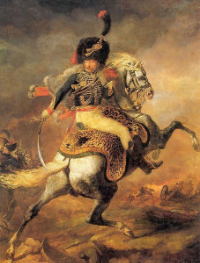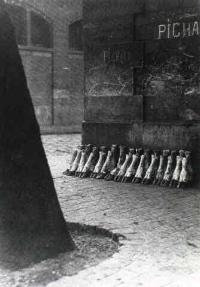A Year of Two Anniversaries
For James Bishop
Théodore Géricault – Two Hundred Years of Modern Art & The Death of Georges Bataille (1897-1962)
In 1812, Géricault painted Le Chasseur de la Garde, which may be said to symbolically mark the beginning of the modern art tradition. The year 2012 represents the 200th anniversary of modern art. In 1991-92, offering yet another anniversary of twenty years, a major retrospective was organized at the Grand Palais in Paris, curated by Sylvain Laveissière and Régis Michel, which I had the good fortune to see. That, and a visit this month of January to the Louvre, where the great painting of 1812 hangs in proximity to two other key works by the artist – Le Cuirassier blessé, quittant le feu and Le radeau de la Méduse – leave an indelible impression. Why assert that this very painting, Le Chasseur de la Garde, is the first work of modern art? The question needs to be answered from numerous points of view: of history; also of a new society; and also of what would eventually emerge, still to this day a work in progress, as the modern subject.
Géricault is the first great artist to arrive after the watershed event of the French Revolution, which can be taken to mark our transition into the modern world. The Old Regime had fallen. The mesmerizing revolutionary period had carried out its mission of destruction. Napoleon had appeared to usher in the New Order, based, ironically, on the same illusions as the Old: of autocracy, martial virtue and national glory. Likewise, the new society of the nineteenth century, impelled by industrial production and a new business and professional class, living in urban centers, the notorious ‘bourgeoisie’, so detested and denigrated by writers and artists such as Baudelaire and Courbet, struggled to preserve the cultural values of the past. The Academy would teach adherence to a hierarchy of genres, treating historical and mythological subjects, and defend the notion of an idealized vision, attained by a neutral paint surface, achieving illusion of the subject. A primary rule of this transition to the modern world is thus established, namely: economic and social innovation will provoke a cultural reaction. Has anything changed in the meantime? This is the contingency that Géricault encounters and resolves to address.
Régis Michel, in the catalog, underlines the main points that define Géricault: he is anti-academic; an original copyist, engaged in “de-forming” the great Italian tradition of painting that was arriving into the Louvre as the spoils of Napoleon’s conquests; a fierce advocate of modern life; a critic-resister of the ‘ideal’; an anti-military and political commentator. In short, Géricault is the quintessential modern artist: “autodidact, outsider, modern and realist.”
Régis Michel’s remarkable commentary tells the story of Le Chasseur de la Garde. In June 1812, Napoleon’s ‘Grande Armée’ crossed the Niemen. The invasion of Russia was underway. In December, quoting Napoleon’s own characterization, a mere handful of “specters” re-crossed the same river, in defeat. Géricault painted his picture in response to “the grandeur and decadence of the notion of imperial exploit”. Modern culture is, therefore, identified at the outset with the discovery that history is folly.
The painting is also notable for its stylistic innovation, which is the most difficult measure in art. Instead of a vast panorama of battle, celebrating martial glory, the artist focuses on the personal drama of one figure in the action. A single element is made to tell the whole story of the scene. The classical subject, hitherto so firmly established, is dislodged. The purpose of the painting is to give birth to a new subjectivity.
In like manner, the artist’s brush-stroke, signature of physical presence, leaves its passage in the paint-matter, declaring an explicit rupture with the neutral paint handling of Classicism and the Academy: “The esthetic of touch, by which the ego is exalted, opposes the esthetic of ‘glacis’, dear to Classicism, which denies matter in the name of the Ideal”.
It is also remarked that the horseman, turning away from the action, has an expression of profound detachment and reflection on his countenance. Michel quotes the contemporary commentary of the celebrated French historian Michelet, to the effect that: “He turns towards us and thinks.” The actual subject of the painting, a cavalry officer named Alexandre Dieudonné, died that December, by a Russian road-side. It is remarked that this name, signifying ‘given by God’, links him to the painter’s given name, Théodore, and suggested that the painting is also a self-portrait. Michel concludes by stating that Géricault, again in Michelet’s characterization, is “the painter of conscience and death’.
With the Chasseur de la Garde, in a development which defines modern art, painting has become a vehicle of thought. I make this assertion, mindful of the profound irony that we still don’t seem to understand today, what we knew already two hundred years ago, when we first beheld Géricault’s great painting.
Georges Bataille, who died fifty years ago, is also a philosopher of war. His L’Expérience Intérieure was published in Paris in 1943 at the height of the German occupation, in an edition of a few hundred copies, of which two thirds remained on his publisher’s shelf. His Sur Nietzsche, published in 1945, at a time when such a literary and philosophical effort would pass with little notice, is framed by the author’s personal experience of war-time Paris, with accounts, in the text, of bombs falling on the roofs of the city all around him, as he writes. In contrast to these statistics, indicating the extremely modest distribution of Bataille’s major books, it is interesting to note in a recent article of the New York Times that the contemporary avant-garde Bomb Magazine, founded in 1981, has today a circulation of 60,000 and its Web site gets one million unique visitors a year.
From the outset of his career in the 1920’s, Bataille was an obscure and esoteric writer, known only to a tiny circle of other writers and artists. In contrast, André Breton was the avant-garde’s popularizing, mediatizing ideologue, who brought his Surrealist movement to America. I have written elsewhere (1) that Breton, together with Marcel Duchamp, founded a New Academy in the twentieth century, in open hostility to modern culture. Bataille, who was never a Surrealist, opposed the institution of such an academy. Bataille was unknown in America up to and beyond the War. The great mid-century American artists, Newman, Pollock and Rothko, among others, do not seem to have been aware of his work. In this, we see how difficult it is for modern thought to be internationally diffused. The same is true today. However, Bataille’s thinking aligns with the painting of these great American artists and it remains for art historians to reconsider their work with this in mind. In contrast, Breton’s position translates into Pop. Again, here is another irony. Where the thinking of a philosopher like Georges Bataille has difficulty passing to an international plane, Pop, which is essentially a local or provincial esthetic, underwritten by Surrealism, goes global in an apparently effortless manner.
The first book of Bataille's essays, translated into English, appeared in 1962 and a copy was in Robert Smithson’s library. In post-war American art, Smithson's 'Spiral Jetty' stands as a monument of modern art, combining intellectual and creative thinking. There is little evidence that other intellectuals, critics or artists in New York at that time paid much attention to the appearance of Bataille's book. I have argued elsewhere (2) that Bataille’s thought enters America, at the creative level, with Robert Smithson. Since then, Bataille's writings have been broadly translated and published in the United States but there is reason to doubt that appreciation of their import and significance has much increased.
Will contemporary art historians soon take up this task of rethinking mid-century American painting in relationship to Bataille? It is to be doubted. Bataille confronts the Neo-Platonic and Kantian methodology of art historiography (3). There is a shocking ‘dissolution’ of epistemology in Bataille’s thought. Bataille sets out to rethink reason. This is why his enemies have called him ‘a pornographer’. Specifically, Bataille’s thought draws attention to the principle of ‘excess’ in human experience. Pointing to the destructive and irrational forces at play in the human psyche, he reminds us of the fragility of our identity. Where this leads is unsettling. Consider, for example, its impact on our American obsession with economic life. Opposing the premise of our ‘Limited Economy’, the competition for scarce resources, Bataille proposes a theory of ‘General Economy’, where human society labors on an Earth which is bloated by the excess energy of the Sun and struggles in an effort to shed, through war and other extreme behavior, what it is unable to productively consume. Such a notion is fundamentally subversive of existing power structures and is met, in our social discourse, with silence. How is one to respond to what one can neither know nor understand?
The stark issue for contemporary culture is that, like it or not, Bataille will make his way. What he has to tell us draws ever closer. In the meantime, the seething issues of Modern Art, as valid today as they were 200 years ago, are reduced in America, and Europe, to fashion and entertainment in the social comedy.
(2) 3000°, catalog of exhibit of the same name at Paul Rodgers / 9W Gallery, July - August 2002


